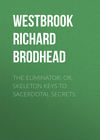Читать книгу: «The Eliminator; or, Skeleton Keys to Sacerdotal Secrets», страница 5
“As the result of my researches, I place Jewish historians, so called, upon the same footing as the Christian ecclesiastical ones, whose works, while containing a base of more or less historical reference and truth, are yet too much overweighted with unhistorical myths to be regarded as genuine, sober history. To my view, the Jews were, at the period I am referring to, in a not dissimilar position to the Druses of Lebanon of the present day. As is well known to a certain class of writers who have come in contact with them, they form a community held together not so much by national ties as by semi-religious ones, which are based upon Cabalistic and theurgic rites and ceremonies. Like what I conceive the Jews to have been in the centuries preceding the Christian era, they are an order rather than a nation, the remains of systems which have continued and survived from ancient times. In this light the Jewish records are intelligible as writings veiled in allegory, treating of their mystic lore, albeit expressed in verbiage that bears a literal meaning upon its surface. I give this as the only solution that presents itself of the mysterious problem under review.”
I now propose to state a few points from the Jewish writings themselves (collated from Bishop Colenso) to show the fabulous character of the history of this pretentious people.
The number of fighting-men who marched out of Egypt is nowhere estimated at less than 600,000, and if this represented only one-fourth of the population, the latter must have reached 3,000,000. If we cut this down one-third, so as to be sure of our figures, we make it 2,000,000 souls.
The number of the children of Israel who went into Egypt was 70 (Ex. 1: 5). They sojourned in Egypt 215 years. It could not have been 430 years, as would appear from Ex. 11:40. The marginal chronology makes the period 215 years, and there were only four generations to the Exodus—namely, Levi, Kohath, Amram, and Moses (Ex. 6: 16, 18, 20). How could these people have increased in 215 years from 70 souls so as to number 600,000 warriors? It would have required an average number of 46 children to each father. The 12 sons of Jacob had between them only 53 sons. At this rate of increase, in the fourth generation there would have been only 6311 males (provided they were all living at the time of the Exodus), instead of 1,000,000. If we add the fifth generation, who would be mostly children, the total number of males would not have exceeded 28,465.
All the first-born males from a month old and upward, of those that were numbered, were 22,273 (Num. 3: 43). The lowest computation of the whole number of the people at that time is 2,000,000. The number of males would be 1,000,000. Dividing the latter number by the number of first-born, gives 44, which would be the average number of boys in each family, or about 88 children by each mother. Or, if where the first-born were females, the males were not counted, the number of children by each mother would be reduced to 44.
Dan in the first generation had but one son (Gen. 46: 23), and yet in the fourth generation his descendants had increased to 62,700 warriors (Num. 2: 26), or 64,400 (Num. 26: 43). Each of his sons and grandsons must have had about 80 children of both sexes. On the other hand, the Levites increased the number of “males from a month old and upward” during the 38 years in the wilderness only from 22,000 to 23,000 (Num. 3: 39; 26: 62), and the tribe of Manasseh during the same time increased from 32,200 (Num. 1: 35) to 52,700 (26: 34).
The whole population of Israel were instructed in one single day to keep the passover, and actually did keep it (Ex. 12). At the first notice of any such feast Jehovah said, “I will pass through the land of Egypt this night.*” The passover was to be killed “at even” on the same day that Moses received the command.
The women were at the same time ordered to borrow jewels of their neighbors, the Egyptians. After midnight of the same day the Israelites received notice to start for the wilderness. No one was to go out of his house till morning, when they were to take their hurried flight with their cattle and herds. How could 2,000,000 people, scattered about over a wide district, as they must have been with their cattle and herds, have gotten ready and taken a simultaneous hurried flight at twelve hours’ notice?
The Israelites, with their flocks and herds, reached the Red Sea, a distance of from fifty to sixty miles over a sandy desert, in three days! Marching fifty abreast, the able-bodied warriors alone would have filled up the road for seven miles, and the whole multitude would have made a column twenty-two miles long, so that the last of the body could not have been started until the front had advanced that distance—more than two days’ journey for such a mixed company. Then the sheep and cattle must have formed another vast column, covering a much greater tract of ground in proportion to their number. Upon what did these two millions of sheep and oxen feed in the journey to the Red Sea over a desert region, sandy, gravelly, and stony alternately? How did the people manage with the sick and infirm, and especially with the seven hundred and fifty births that must have taken place in the three days’ march?
Judah was forty-two years old when he went down with Jacob into Egypt, being three years older than his brother Joseph, who was then thirty-nine. For “Joseph was thirty years old when he stood before Pharaoh” (Gen. 41: 46); and from that time nine years elapsed (seven of plenty and two of famine) before Jacob came down into Egypt. Judah was born in the fourth year of Jacob’s double marriage (Gen. 29: 35), being the fourth of the seven children of Leah born in seven years; and Joseph was born of Rachel in the seventh year (Gen. 30: 24, 26; 21: 41). In these forty-two years of Judah’s life the following events are recorded in Gen. 38:
He grows up, marries, and has three sons. His eldest son grows up, marries, and dies. The second son marries his brother’s widow and dies. The third son, after waiting to grow to maturity, declines to marry the widow. The widow then deceives Judah himself, and bears him twins—Pharez and Zarah. One of these twins grows up and has two sons—Hez-ron and Hamul—bom to him before Jacob goes down into Egypt.
In Ex. 30:11-13, Jehovah commanded Moses to take a census of the children of Israel, and in doing it to collect half a shekel of the sanctuary as atonement-money. This expression “shekel of the sanctuary” is put into the mouth of Jehovah six or seven months before the tabernacle was made. In Ex. 38: 26 we read of such a tribute being paid, but nothing is there said of any census being taken, only that the number of those who paid, from twenty years old and upward, was 603,550 men. In Num. 1: 1-46, more than six months after this occasion, an account of an actual census is given, but no atonment-money is mentioned. If in the first instance a census was taken, but accidentally omitted to be mentioned, and in the second instance the tribute was paid, but accidentally omitted likewise, it was nevertheless surprising that the number of adult males should have been identically the same (603,550) on both occasions, six months apart.
Aaron and his two sons were the only priests during Aaron’s lifetime. They had to make all the burnt-offerings on a single altar nine feet square (Ex. 37: 1), besides attending to other priestly duties for 2,000,000 people. At the birth of every child both a burnt-offering and a sin-offering had to be made. The number of births must be reckoned as at least two hundred and fifty a day, for which consequently five hundred sacrifices would have to be offered daily—an impossible duty to be performed by three priests. For poor women pigeons were accepted instead of lambs. If half of them offered pigeons, and only one instead of two, it would have required 90,000 pigeons annually for this purpose alone. Where did they get the pigeons? How could they have had them at all under Sinai? There were thirteen cities where the presence of these three priests was required (Josh. 21: 19). The three priests had to eat a large portion of the bumt-offerings (Num. 18: 10) and all the sin-offerings—two hundred and fifty pigeons a day—more than eighty for each priest.
In keeping the second passover under Sinai, 150,000 lambs must have been killed—i. e. one for each family (Ex. 12: 3, 4). The Levites slew them, and the three priests had to sprinkle the blood from their hands (1 Chron. 30: 16; 35: 11). The killing had to be done “between two evenings” (Ex. 12: 6), and the sprinkling had to be done in about two hours. The killing must have been done in the court of the tabernacle (Lev. 1: 3, 5; 17: 2-6). The area of the court could have held but 5000 people at most. Here the lambs had to be sacrificed at the rate of 1250 a minute, and each of the three priests had to sprinkle the blood of more than 400 lambs every minute for two hours.
The number of warriors of the Israelites, as recorded at the Exodus, was 600,000 (Ex. 7: 37); subsequently it was 603,550 (Ex. 38: 25-28), and at the end of their wanderings it was 601,730 (Num. 26: 51). But in 2 Chron. 13:3, Abijah, king of Judah, brings 0,000 men against Jeroboam, king of Israel, with 0,000, and “there fell down slain of Israel 500,000 chosen men” (ver. 17). On another occasion, Pekah, king of Israel, slew of Judah in one day, 120,000 valiant men (2 Chron. 28: 6.)
The Israelites at their Exodus were provided with tents (Ex. 16: 16), in which they undoubtedly encamped and dwelt. They did not dwell in tents in Egypt, but in “houses” with “doors,” “sideposts,” and “lintels.” These tents must have been made either of hair or of skin (Ex. 26: 7, 14; 36: 14, 19)—most probably of the latter—and were therefore much heavier than the modern canvas tents. At least 200,000 were required to accommodate 2,000,000 people. Supposing they took these tents from Egypt, how did they carry them in their hurried march to the Red Sea? The people had burdens enough without them. They had to carry their kneading-troughs with the dough unleavened, their clothes, their cooking utensils, couches, infants, aged and infirm persons, and food enough for at least a month’s use, or until manna was provided for them in the wilderness, which was “on the fifteenth day of the second month after their departure out of the land of Egypt” (Ex. 16:1). One of these tents, with its poles, pegs, etc., would be a load for a single ox, so that they would have needed 0.000 oxen to carry the tents. But oxen are not usually trained to carry goods on their backs, and will not do so without training. Then it is written:
“These be the words which Moses spake unto all Israel” (Deut. 1: 1).
“And Moses called all Israel and said unto them” (Deut. 5:1).
“There was not a word of all that Moses commanded, which Joshua read not before all the congregation of Israel, with the women, and the little ones, and the strangers that were conversant among them” (Josh. 8: 35).
How was it possible to do this before at least
2,000,000 people? Could Moses or Joshua, as actual eye-witnesses, have expressed themselves in such extravagant language? Surely not.
The camp of the Israelites must have been at least a mile and a half in diameter. This would be allowing to each person on the average a space three times the size of a coffin for a full-grown man. The ashes, offal, and refuse of the sacrifices would therefore have to be carried by the priest in person a distance of three-quarters of a mile “without the camp, unto a clean place” (Lev. 4:11, 12.) There were only three priests—namely, Aaron, Eleazar, and Ithamar—to do all this work for 2,000,000 people. All the wood and water would have to be brought into this immense camp from the outside. Where could the supplies have been got while the camp was under Sinai, in a desert, for nearly twelve months together? How could so great a camp have been kept clean?
But how huge does the difficulty become if we take the more reasonable dimensions of twelve miles square for this camp; that is, about the size of London! Imagine at least half a million of men having to go out daily a distance of six miles and back to the suburbs for the common necessities of nature, as the law directed.
The Israelites undoubtedly had flocks and herds of cattle (Ex. 34: 3). They sojourned nearly a year before Sinai, where there was no food for cattle; and the wilderness in which they sojourned nearly forty years is now and was then a desert (Deut. 32: 10; 8: 15). The cattle surely did not subsist on manna!
Among other prodigies of valor, 12,000 Israelites are recorded in Num. 31 as slaying all the male Midianites, taking captive all the females and children, siezing all their cattle and flocks, numbering 808,000 head, taking all their goods and burning all their cities, without the loss of a single man. Then they killed all the women and children except 32,000 virgins, whom they kept for themselves. There would seem to have been at least 80,000 females in the aggregate, of whom 48,000 were killed, besides (say) 20,000 boys. The number of men slaughtered must have been about 48,000. Each Israelite therefore must have killed 4 men in battle, carried off 8 captive women and children, and driven home 67 head of cattle. And then after reaching home, as a pastime, by command of Moses, he had to murder 6 of his captive women and children in cold blood.
Now, I respectfully submit that, judging from the account of the Exodus of the Jews, which they have written themselves, we cannot credit it. The narrative is full of contradictions, and is so absurd and incredible, and even impossible, that we must regard it as a huge myth. There may have been an Exodus from Egypt, of which this account is an exaggeration, but it bears so many evidences of the fabulous that we cast it aside and are led to doubt whether the Jews were ever in Egypt except as tramps and vagabonds, and to suspect that the whole story is an adapted history of some great exodus of some ancient tribes written for a purpose.
I think it has been shown that the Jews were not the people that they have been supposed to be. They are a modern people in the world’s history, antedated by many highly-civilized and powerful nations. They are not descendants of Abram, as will be shown more fully hereafter, and their population never reached the fabulous numbers that are given in what is called their sacred history. Indeed, there is so much of the fabulous about them, so much of false pretence that upon the very face is impossible and incredible, that the wonder is that Christians should ever have seriously thought of regarding them and their institutions as the source and substance of what Christianity is. We have no prejudice against the Jews. We cast no reflection upon the so-called Hebrews of the present day. They are not responsible for their ancestors, any more than Gladstone, Huxley, Tyndall, Spencer, and other brainy Englishmen are responsible for the savagery and barbarism of their forefathers.
It has been our object in this chapter to show the Munchausenish character of Jewish history, upon which the whole superstructure of modern theology rests. If anybody is proud of his descent from such a people, he is welcome to the glory.
CHAPTER IV. MOSES AND THE PENTATEUCH
“But even unto this day, when Moses is read, the veil is upon their heart.”—2 Cor. 3:15.
THE first five books of the Old Testament, supposed by many to have been written by Moses, are called the Pentateuch. In the early chapters of Genesis, in the “Authorized Version,” there is placed at the head of the page in the margin, “a. m. 1,” which mean Anno Mundi—the year of the world—one, and immediately below it are the letters “b. c.”—which mean Before Christ—“4004.” This is the system of chronology established by Archbishop Ussher, and means that 4004 years before Christ the world was one year old. It is claimed that Moses promulgated the law about 1451 b. c., and this must have been about two thousand five hundred and fifty-three years after the Creation, which added to 1890, the present date, would make the world just five thousand eight hundred and ninety-four years old. Lyell, a most judicious geologist estimated the delta of the Mississippi at one hundred thousand years, and some persons think these figures should have been doubled. Professor John Fiske thinks the glacial period began two hundred and forty thousand years ago, and that human beings inhabited Europe at least one hundred and sixty thousand years earlier, thus giving an antiquity to our race of not less than four hundred thousand years. Other scientists talk of hundreds of thousands, and even millions, of years, but we attach no importance to specific figures. We simply insist upon an antiquity which very far exceeds six thousand years.
Learned Egyptologists place Rameses II., the Pharaoh of the Jewish captivity, whose mummy is now to be seen in the museum at Cairo, at 1390 years b. c. It seems strange that his mummy should be on exhibition in a museum when “he and all his hosts were swallowed up in the Red Sea.” If we are told that Rameses II. was succeeded by Sethi II., we find from Egyptian records that both of these kings lived to a good old age, and the mummy of each has been preserved, and not even a hint is given that either of them was drowned. But we have, according to the tables of Abydos and Bunsen, which are generally accepted, three thousand six hundred and twenty years before Christ as the time in which Menes, the first monarch of Egypt, reigned, making two thousand two hundred and thirty years as the period of the Egyptian monarchy before the reign of Rameses II.
But I contend that Egyptian civilization extends back at least seven thousand years, and Miss Amelia Edwards, the Egyptologist, who has recently lectured in our Pennsylvania University course, thinks ten thousand years not too high an estimate. In support of ibis hypothesis, the great antiquity of man, which no scholar now disputes, carries us back many thousands of years beyond Menes, and there are many facts which favor the assumption that the valley of the Nile was one of the places inhabited for an indefinite period. The works of art—monuments, architecture, paintings, etc.—show an antiquity that cannot be estimated. Manetho, an Egyptian priest, who wrote a history of Egypt, by request of Ptolemy II., two hundred and eighty-six years before Christ, carries us back more than seven thousand years.
The Pentateuch is a compilation by several authors, and hence its patchwork character. Professors Ewald and Kuenen and others have proved this, and Dean Stanley, of the English Establishment, has admitted it. Some portions may have been compiled eight hundred or nine hundred years before Christ, but not the two contradictory accounts of the creation and fall of man. The Assyrian cuneiform tablets, which were discovered in 1873 and 1874 a. d., and which are now in the British Museum, show that this ancient people had this story about two thousand years before the time of Moses. The Jews learned it in Babylon, and none of the other Old-Testament writings contain any notice of it, because it was not known until after the return of the Jews from their captivity in Babylon, five hundred and eighteen years before Christ. Is it not reasonable to suppose that the various Old-Testament writers would have made some reference to the Pentateuch had they known of its existence? Professor François Lenormant of the National Library of France, a most learned archaeologist and palaeontologist, and a most devout Christian, in his Beginnings of History admits that the Jews borrowed substantially the story of the creation and the fall from more ancient nations, and furnishes the original copies. The legends recorded in Genesis are found among many ancient peoples who lived many centuries before Moses; and Berosus, a priest of the temple of Belus, who wrote two hundred and seventy-six years before Christ, affirms that fragments of Chaldean history can be traced back 15 Sadi or 150,000 years. I have mentioned these things because they are germane to what is to follow.
There is good reason for thinking that the book of Deuteronomy was written about six hundred and twenty-one years before Christ, and the remaining books of the Pentateuch were of later date, coming down to four hundred and fifty years before Christ. This Professor Kuenen has demonstrated beyond controversy in his Religion of Israel, to which I must refer for his arguments in detail. The best scholarship of the world does not believe that what is called the Law of Moses was written prior to the fifth or sixth century before Christ, and learned men in Holland, Germany, and England, as well as the most advanced thinkers in America, now accept this opinion. Professor Robertson Smith, in the Encyclopœdia Britannica, adopts this view, and Dean Stanley, in his Jewish Church, does not leave us in doubt as to his opinion.
Take the following as an example of what I mean (Gen. 12:6): “And the Canaanite was then in the land;” whereas the expulsion of the Canaanites did not occur until several centuries after the death of Moses, when this must have been written. In Gen. (36: 31) we read, “Before there reigned any king over Israel.” This must have been two hundred years after the death of Moses. “The nations that were before you” (Lev. 13: 8) of course presupposes that the Canaanites had already been subdued. “Now the man Moses was very meek, above all the men that were upon the face of the earth” (Num. 12:13), could hardly have been written by Moses himself. The expression “unto this day” frequently occurs, and shows that the time was long after the events took place. It is also implied in various places that the writer resided in Palestine, and so it could not have been Moses. In Deuteronomy (19: 14) we read, “Thou shalt not remove thy neighbor’s landmark which they of old time have set in thine inheritance.” They had no landmark to remove, unless this was written concerning the land of Canaan long after the death of Moses. They are reproached for not keeping the Sabbath in the past for a long time, and this is given as a reason for the Captivity; and hence Leviticus 26:34, 35, 43 was written after the Captivity, which began in 597 b. c. In Gen. 14:14, Lot is taken prisoner and rescued from his captors, whom they “pursued unto Dan.” Now, there was no such place as Dan until after the entrance into Canaan. We read in Judg. 18:27, 29 that this city was called Laish, which was burned by the Israelites, and then they built a city, and they called it “Dan, after the name of their father: howbeit the name of the city was Laish at first.” This “trout in the milk” is as striking as if some one should write of Chicago when the Declaration of Independence was signed. In Gen. 36:31 we read, “And these are the kings that reigned in the land of Edom before there reigned any king over the children of Israel.” This passage shows that it was written after there had been kings in Israel, and could not have been written by Moses. I could show similar incongruities concerning the manna in Gen. 16: 35, compared with Josh. 5: 12. So Deut. 24: 14 must have been written after the entrance into Canaan, as until then they had no lands, and there were no gates and no “strangers within their gates.” The same might be said of the fourth commandment of the Decalogue: the Israelites had no gates until after they entered Canaan. It could not have been written by Moses in the wilderness of Arabia.
These illustrations might be produced indefinitely, but enough have been given to show that the Pentateuch was written several hundred years after the death of Moses, and that we are justifiable in fixing the date for most of it in the fourth, fifth, or sixth century before the Christian era. The Pentateuch abounds in duplicate traditions of the same transactions, and also in diversity and contradictions. These numerous repetitions are fatal to the supposition that it was written by Moses. If Moses was the author of the Pentateuch, we should expect to find a good many hints of this in other parts of the Bible; whereas we have no reference to Sinai and its awful thunders, and, although Moses is mentioned in the New Testament, it only shows the existence of traditions to that effect at that time. Not until the time that Christianity arose, about thirteen hundred years after the death of Moses, did the tradition obtain currency that he was the author of the Pentateuch.
The fact is, the Jews are a comparatively modern people, and were not known as a nation until the time of Alexander the Great (356-325 b. c.), and Herodotus, by never mentioning them, so indicates. While the Hindoos, Egyptians, Grecians, Romans, Chaldeans, and Babylonians had their men of science, literature, and law, whose fame only brightens with the flight of time, the Jews have no history except what was written by themselves, and that is so absurd, impossible, and contradictory that nobody can believe it.
Everybody knows that the ancient Jews were the constitutional imitators of other peoples. They have always been the second-hand clothes-dealers of the world. As a race they never have been noted for originality, but have always been ready to borrow what belonged to other people, and then, with characteristic self-complacency, have claimed to be the “original Jacobs” of everything good and great. We intend this as no reflection upon the Jews of the present day.
Staniland Wake, an English writer, in his great work on the Evolution of Morality, vol. ii., page 59, thus expresses his views: “Judging from this fact, many persons imagine—or at least, from the superstitious reverence that they have for the Decalogue, appear to do so—that until the time of the Hebrew lawgiver the most ordinary rules of morality were unknown. The mere fact of Egypt being the starting-point of the Exodus ought to be sufficient to disabuse the mind of this idea, without reference to the contents of the code itself. But the moral laws given in the Decalogue are of so primitive a character that it is absurd to suppose, except on the assumption that the Hebrews were at that period in a condition of pure savagery, that God would personally appear to give his immediate sanction to them. The commands, Honor thy father and thy mother, Thou shalt not kill, Thou shalt not commit adultery, Thou shalt not steal, Thou shalt not bear false witness against thy neighbor, Thou shalt not covet, were simply reiterations of laws to which the Hebrews had been subject during their whole sojourn in Egypt, and which must, in fact, have been familiar to them before their ancestors left their traditional Chaldean home.”
Then we must bear in mind that Moses himself was an Egyptian by birth, and that he was brought up at the court of Pharaoh until he was forty years of age, and in Acts 7: 22 we are told that “Moses was learned in all the wisdom of the Egyptians, and was mighty in words and in deeds.”
The whole matter relating to the Pentateuch is thus summed up by the late Prof. John Wm. Draper, M. D., LL.D., late of the University of New York, in his Conflict between Religion and Science: “No man may dare to impute them (the books of the Pentateuch) to the inspiration of Almighty God, their inconsistencies, incongruities, and impossibilities, as exposed by many learned and pious modern scholars, both German and English, are so great. It is the decision of these critics that Genesis is a narrative based upon legends; that Exodus is not historically true; that the whole Pentateuch is unhistoric and un-Mosaic: it contains the most extraordinary contradictions and impossibilities, sufficient to involve the credibility of the whole—imperfections so conspicuous that they would destroy the authenticity of any modern historical work.”… “To the critical eye they all present peculiarities which demonstrate that they were written on the banks of the Euphrates, and not in the desert of Arabia. They contain many Chaldaisms.”… “From such Assyrian sources the legends of the creation of the earth and heavens, the Garden of Eden, the making of man from clay and the woman from one of his ribs, the temptation of the serpent, etc.,… were obtained by Ezra.” “I agree in the opinion of Hupfeld, that the discovery that the Pentateuch is put together out of the various sources of original documents is beyond all doubt, is not only one of the most important and most pregnant with consequences for the interpretation of the historical books of the Old Testament—or rather for the whole of theology and history—but it is also one of the most certain discoveries which have been made in the domain of criticism and the history of literature.”
But not only do the laws of Egypt antedate the laws accredited to Moses, but the Hindoos had laws which were yet more ancient. The writings of Buddha, who died in 477 b. c., refer to older books and quote from them, and these again refer to still older books, until we reach laws which existed many thousands of years before the Law of Moses, as the laws of Manu were drawn from the “immemorial customs” of the nation and constitute a kind of common law. “The most accurate scholars point to India as the origin of Egyptian civilization,” says Le Renouf, the learned Egyptologist.
If Egyptian literature was derived in a remote period from India, what must be the date of old India’s laws as compared with the laws of the Hebrews? It is no wonder that Max Müller, professor in the orthodox University of Oxford, says (in Chips, vol. i., p. 11): “After carefully examining every possible objection that can be made against the date of the Vedic hymns, their claim to that high antiquity which is ascribed to them has not, as far as I can judge, been shaken.” The same learned Sanskrit scholar says, “The opinion that the pagan religions were mere corruptions of the religion of the Old Testament, once supported by men of high authority and great learning, is now as completely surrendered as the attempt at explaining Greek and Latin as corruptions of Hebrew” (Science of Religion, p. 24). This great Sanskrit scholar admits in many places in his voluminous writings the greater antiquity of the pagan scriptures, and gives many weighty reasons to show how impossible and absurd it is to suppose that they have been changed and interpolated to adapt them to more modern times.






























